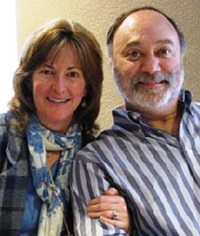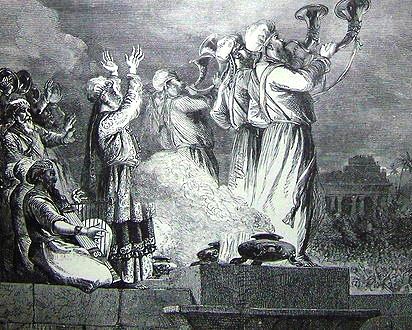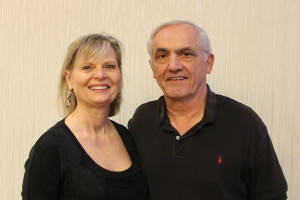In an essay entitled “Guidelines to an Understanding of the Person and Work of the Holy Spirit,” Dr. Gary Deddo offers an incarnational, Trinitarian perspective on the doctrine of the Holy Spirit. Over the next several weeks we’ll publish his essay serially in seven parts. Here is part two (to read other parts, click a number: 1, 3, 4, 5, 6, 7).
One in being, distinct in Person
As noted in part one of this series, it’s important to avoid thinking that the Divine Persons have divergent purposes or that they operate independently of one another. The Triune God is one in being, and the three Divine Persons are one in act. Whether in creation, redemption or in the perfecting of the creation, the Persons act together as the one God. We see this in the many Scriptures where the Persons are linked in a particular act (work) of God. However, there are times when Scripture shows the Persons working in distinct ways. For example, the Son becomes incarnate in a way that is distinct from the Father and the Spirit. Also, at Pentecost, the Spirit descends and indwells the believing church in a way that is distinct from the Father and the Son.
Even when two or three of the Persons are shown to be joined in a particular act of God, there often is a distinction as to their particular role in that act. In fact, Scripture seems to indicate that each Person is involved in a particular way in every act that the Persons do together. Each, from their own “angle,” contributes in a unique way to the unified act. We could say that one Person “takes the lead” in certain actions: the Father in creation, the Son in atonement, the Spirit in the perfecting of creation. To speak of such distinctions in this way is fine, so long as we don’t think of the Persons as acting separately or as being out of phase with one another in what is a conjoint act. In formal theology this is called the doctrine of appropriation. An act can be “appropriated” to the Person of the Trinity who takes the lead, as long as the other two are not regarded as having nothing to do with it, but are co-involved, each in their own way.
Also, we should not think that the distinction, in their contribution to an act external to their triune being, is what makes or constitutes their being as distinct in their Persons. The error here is to think, for instance, that being the Creator is what makes the Father different in Person from the Son, or that being Incarnate is what makes the Son different in Person from the Father. No, rather the Father is the Father and the Son the Son and the Spirit the Spirit whether or not they perform any actions external to their own triune being. Rather, they are distinguished by their internal relationships not by their external actions. The being of God is not dependent upon his relationship to something that is external to God, to something that is not God.
As long as we don’t leave the Son and the Spirit behind, we can say the Father leads in creation. We can say the Son leads in our redemption. But if we think the Father is absent or has a different view, attitude, purpose or intention for the Cross than does the Son, then we have split the Trinity apart, placed them at odds with one another! Even in Jesus’ earthly life, we need to remember that he only does what he sees the Father doing. He only says what the Father is saying. They’re saying things together. They’re doing things together. They’re never separate because they’re one in being.
It is proper to say the Son takes the lead and that only the Son is incarnate. We can affirm that the Son physically suffers on the cross and not the Father or Spirit. Not being incarnate in our humanity, they cannot physically suffer and die. But if we think the Father was absent or the Spirit’s had gone on vacation and wasn’t around when Jesus was on the Cross, then we’ve strayed way off the theological path. The Spirit and the Father were present with Jesus, each in their own non-incarnate way. Jesus said, “Father into your hands, I commend my Spirit.” In the book of Hebrews we read, “How much more shall the blood of Christ, who through the eternal Spirit offered himself without blemish to God, purify your conscience from dead works to worship the living God” (9:14). They’re all acting together in Christ’s redeeming work. Yes, we can say one leads. But don’t let them fall apart just because one is leading.
The Spirit perfects. But he perfects human beings with the perfection that is accomplished by Christ. The Spirit shares with us the holiness and the sanctification of Jesus in our humanity. He doesn’t give us a spiritualized or divine perfection, a non-bodily, inhuman existence. But rather the Spirit joins us to Christ’s glorified human body, mind and soul.
The Spirit makes us to share in Jesus’ self-sanctification. The work of the Spirit is not separate from the work of the Son, but the Spirit does lead in dwelling in us now. We can talk about the ways the Spirit leads, but we shouldn’t think of the Spirit then as branching off and saying, “Father and Son, you’ve done a good job over there, but now I’ve got to go do something over here that you don’t have anything to do with. It’s my turn to do my own thing.” To think in that way is a mistake. That could happen only if God wasn’t one in being and was three beings—tritheism! We don’t want to go there.
We can distinguish between the various contributions the Father, the Son and the Spirit make by the way they take their lead, but we don’t want to separate them or place them in any kind of opposition or in tension with each other. And we don’t want to say that their differing contributions to what they accomplish together are what make them distinct in Person from all eternity. We can distinguish but we should not separate. The Divine Persons are one in being and distinct in Person, not only in their internal and eternal being, but also in terms of what they do towards creation, in creation, redemption and consummation.
Projecting on God
Why do we get tripped up in this? I think there are a number of reasons, but one of them is that we tend to think of God in ways we think of ourselves. We start with ourselves and then try to get to our understanding of God. Think of how we usually distinguish ourselves from each other. How do I know I’m not you and you’re not me? I note: you have a different body. You’re over there and I’m over here. You do this but I do that. You live there but I live here. You think that’s funny, but I don’t. I want X, but you want Y. We’re different in all these ways and that’s how we know we are distinct persons.
So we can project this perspective on God and think that’s how the Father, Son and Spirit are distinguished. The Father is over here, the Spirit’s over there. The Father wants A and the Son wants B. They each have different jobs to do. We try to distinguish them from each other in the same way we distinguish ourselves. But God is not a creature like we are. So, we can’t just take the idea of how we distinguish ourselves and apply it in the same way to God. Thinking that way would only work if God were a creature.
Names and relations
The essential way we have been given to distinguish between the Divine Persons is by means of their different names: the Father, the Son and he Holy Spirit. The different names reveal a difference of their Persons. That is also why we believe there are three, not four or two. We are given three names, not two or seven. The names we are given are revelatory of real distinctions in God, otherwise they wouldn’t be revelatory! They are not just arbitrary words, concepts, ideas, or conventional labels. So we address God in worship, in prayer, by means of these three names. In doing this we follow Jesus’ example and instruction. He uses these names in his relationship to the Father and Spirit and directs us to do so as well. So, for example, he instructs us: “Pray like this: Our Father in heaven…”
Those names also represent and so reveal unique relationships. The Father has a different relationship with the Son than the Son has with the Father. And the Spirit has a different relationship to the Father than does the Son. The names identify and reveal to us unique relationships. Following biblical teaching, we can also find distinct designations for the different relationships.
Corresponding to the Father is the relationship of begetting to the Son. Begetting is the special term used to describe more particularly how the Son comes from the Father. The Father begets the Son. Begetting indicates a certain kind of relationship. In the early church they recognized that begetting is different from making. What is made is of a different kind of thing than the maker. But what is begotten is of the identical kind of being. So we say that the Son is begotten, indicating a unique kind of relationship to the Father. The Son is distinct from the Father but of the identical kind of being, namely, divine, fully God. The Son doesn’t beget the Father and the Father isn’t begotten by the Son. They each have a different relationship with each other, and that difference of relationship (which is internal and eternal to God) is what makes them personally distinct from one another. So we say that the Father begets (is not begotten of the Son) and we say that the Son is begotten (does not beget the Father).
The unique names and relationships identify who the Persons are. They are who they are in relationship with each other. Without the relationships with each other, they would not be who they are. They are not interchangeable. The Father is not the Son, the Son is not the Father. Being the begetter and being the begotten one are different and not reversible. There’s a direction to the relationships, and we can’t reverse them. We can’t say the Son begets the Father. The Son has always been the begotten Son. The Father has always begotten the Son. The Son is eternally the Son, and the Father, eternally Father. That’s why we can identify them as the divine Persons of Father and Son.
But the words/names don’t explain everything. They represent what we have to go on and explain, namely, what they do and don’t mean as far as we can tell. In the case of the Father and Son, we have to rule out, or “think away” as Athanasius said, some aspects of the meaning of the words begotten or begetting as used of human creatures. Among creatures these words include the idea of a time sequence. But when it comes to God, the aspect of time doesn’t apply. God is eternal and so, then, are the Divine Persons. The Father generates (begets) the Son from all eternity. Time sequence doesn’t apply to God. There never was a time when the Son was not. The Son was always the begotten Son of the Father, which is to say the Son is eternally the Son and the Father is eternally the Father, begetting the Son. The discipline of theology is to discern where and how words when used to refer to God must be used differently from how they are used of creatures. This task would be impossible if we did not have biblical revelation to lead us.
Now what about the Spirit? There’s always been the Holy Spirit and the Holy Spirit has eternal relationships with the Father and the Son. We use a special word to talk about those relationships. The New Testament gives us a clue as to one word good to use. We say the Holy Spirit proceeds from the Father and, or through, the Son (John 15:26). Another word has also been used down through the ages to indicate that unique relationship, “spirates.”
The Holy Spirit—proceeds/spirates
These words indicate unique and non-interchangeable relationship. The name and relationship indicate who the Spirit is. The Spirit would not be the Spirit without spirating from the Father and the Son. And the Father and Son wouldn’t be Father and Son without the Spirit proceeding. The relationship of the Spirit is essential to who the Spirit is and so to who the Triune God is. God wouldn’t be God without the Person of the Holy Spirit.
We likely want to ask, “So how does that work? How does a ‘procession’ work in God?” We don’t actually know. We can’t say exactly how it is different from begetting or being begotten. Along with the name, Holy Spirit, the word simply indicates that there is a unique kind of relationship of the Spirit with the Father and the Son, one that is different from the relationship of the Son to the Father. It indicates that the Spirit is from the Father and through the Son in a way that the Son and Father do not proceed from the Spirit and are not the Spirit. With this unique relationship, the Spirit is not interchangeable with the other Persons. It means that the Holy Spirit has always been the Holy Spirit. We affirm in this way that God has always been a Trinity. There never was a time when God was not Triune.
In summary then, the three Divine Persons eternally exist in absolutely unique relationships, and that is what is essential to their being distinct Persons. That’s it. They have unique relations. Each one has a different relationship with the others. We don’t know how to explain what all that means, but we use unique words because there are unique relations. That’s also why we address them according to their unique names that correspond with the relations.
The Father is the Father, not the Son. The Son is the Son, not the Father. The Holy Spirit is the Holy Spirit of the Father and the Son. We have unique names to indicate the unique persons and they have unique relationships and they’re not interchangeable. In these ways we honor what we are given by Jesus and through Scripture as if what we are given is revelatory, as if God has actually fulfilled his will and desire to make himself known to us so that we now have accurate and faithful ways to speak about and know God.
When God through Jesus says, to address him as Father, Son and Holy Spirit we’re being told something real and accurate about God. We’re getting to know God as Jesus knows the Father and Spirit. He’s sharing with us his insider knowledge of God so we too can know and trust the whole triune God. Recall John 1:18, “No one has ever seen God, but the one and only Son, who is himself God and is in closest relationship with the Father, has made him known.” The triune name identifies who God is, which God we’re speaking of, and even what kind of God, God is. God is the Triune God. That’s the only God that is or has ever been. God is Father, Son and Spirit. The Father is the Father. The Son is the Son. The Holy Spirit is the Holy Spirit. Don’t separate them, they’re one in being. In that way we avoid the misunderstanding/heresy that has been called tritheism. But don’t collapse them into one Person with no relationships; they’re distinct in Person. In that way we avoid the opposite misunderstanding/heresy that has been called modalism.
Next time we’ll look more deeply into how God is said to be “one in three” and “three in one.”
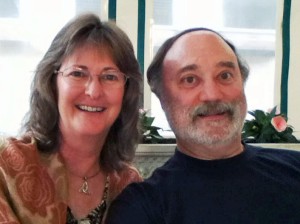 Last week was an important and positive milestone in the history and future of GCI. Thirty-three men and women gathered in Dallas, Texas to finalize a new structure for our U.S. Church Administration and Development (CAD) team. That structure will be implemented in January 2015. In early October, we’ll announce the details in a letter to all U.S. pastors and provide a summary here in GCI Weekly Update.
Last week was an important and positive milestone in the history and future of GCI. Thirty-three men and women gathered in Dallas, Texas to finalize a new structure for our U.S. Church Administration and Development (CAD) team. That structure will be implemented in January 2015. In early October, we’ll announce the details in a letter to all U.S. pastors and provide a summary here in GCI Weekly Update. 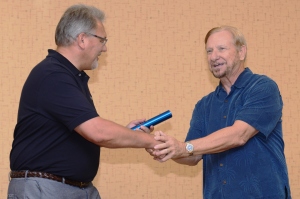 A highlight of the Dallas gathering occurred when CAD director Dan Rogers “passed the baton” of CAD leadership to Greg Williams (see picture at left). Greg will become the new CAD director when Dan retires at the end of this year. During the ceremony, Dan quoted Paul’s words to his protégé Timothy: “You then, my son, be strong in the grace that is in Christ Jesus. And the things you have heard me say in the presence of many witnesses entrust to reliable people who will also be qualified to teach others” (2 Timothy 2:1-2).
A highlight of the Dallas gathering occurred when CAD director Dan Rogers “passed the baton” of CAD leadership to Greg Williams (see picture at left). Greg will become the new CAD director when Dan retires at the end of this year. During the ceremony, Dan quoted Paul’s words to his protégé Timothy: “You then, my son, be strong in the grace that is in Christ Jesus. And the things you have heard me say in the presence of many witnesses entrust to reliable people who will also be qualified to teach others” (2 Timothy 2:1-2).






